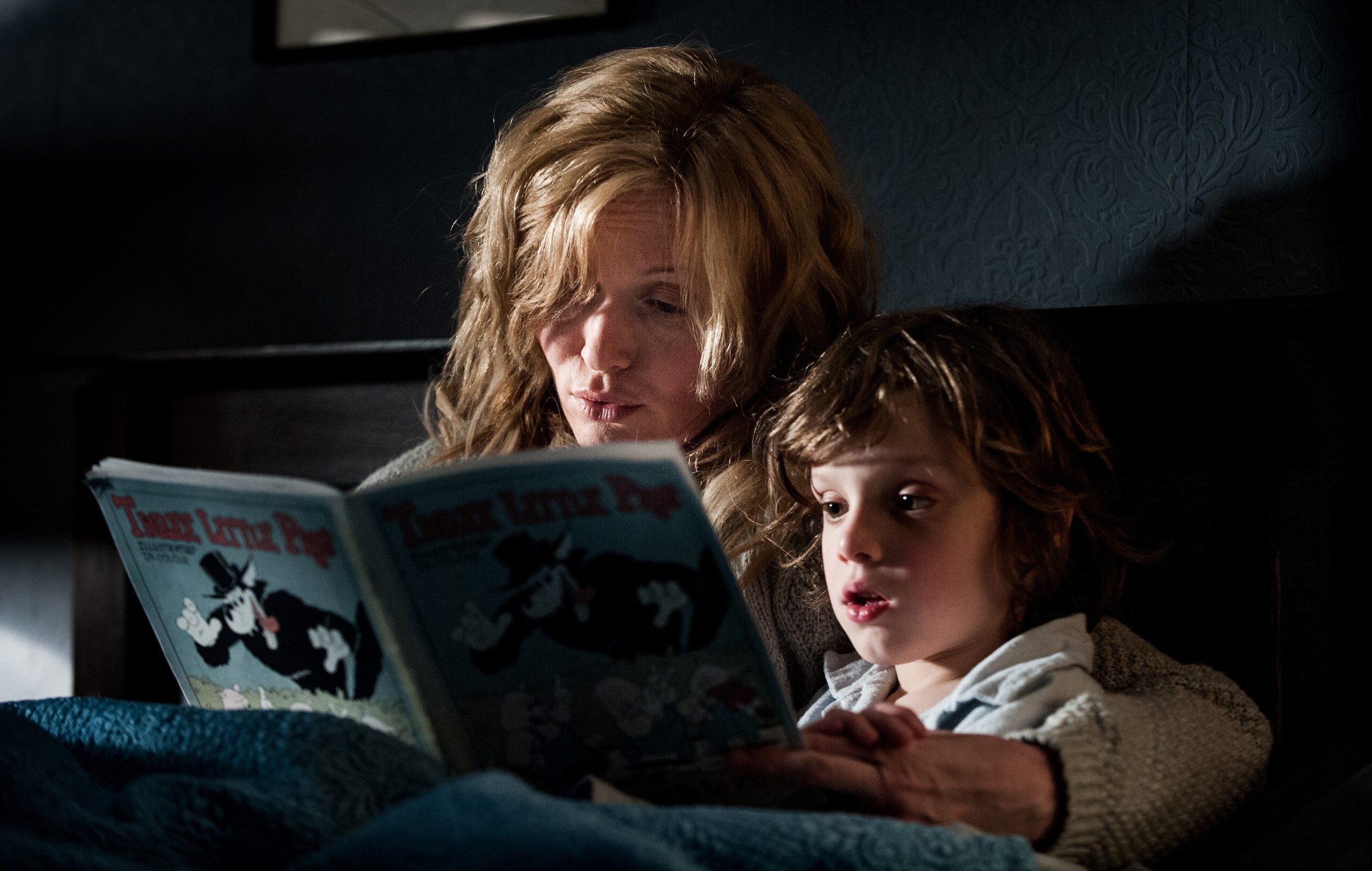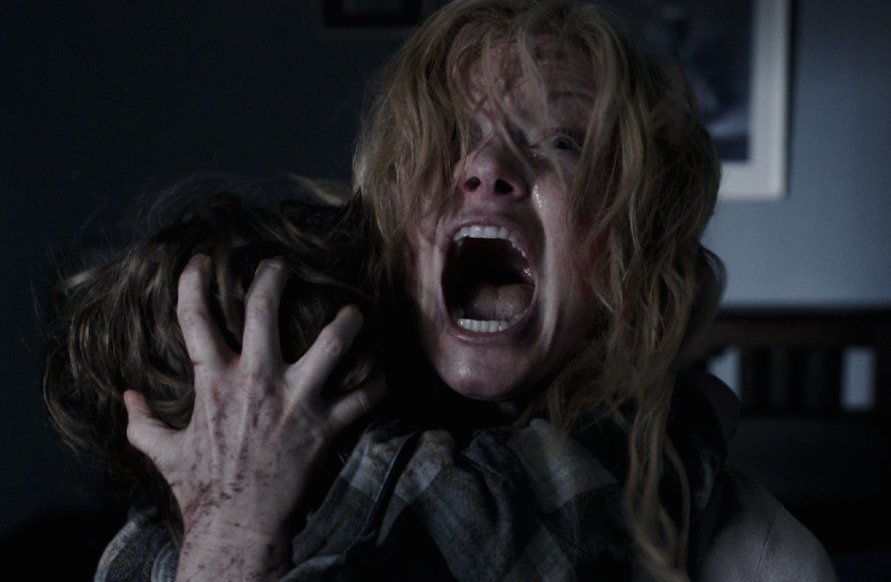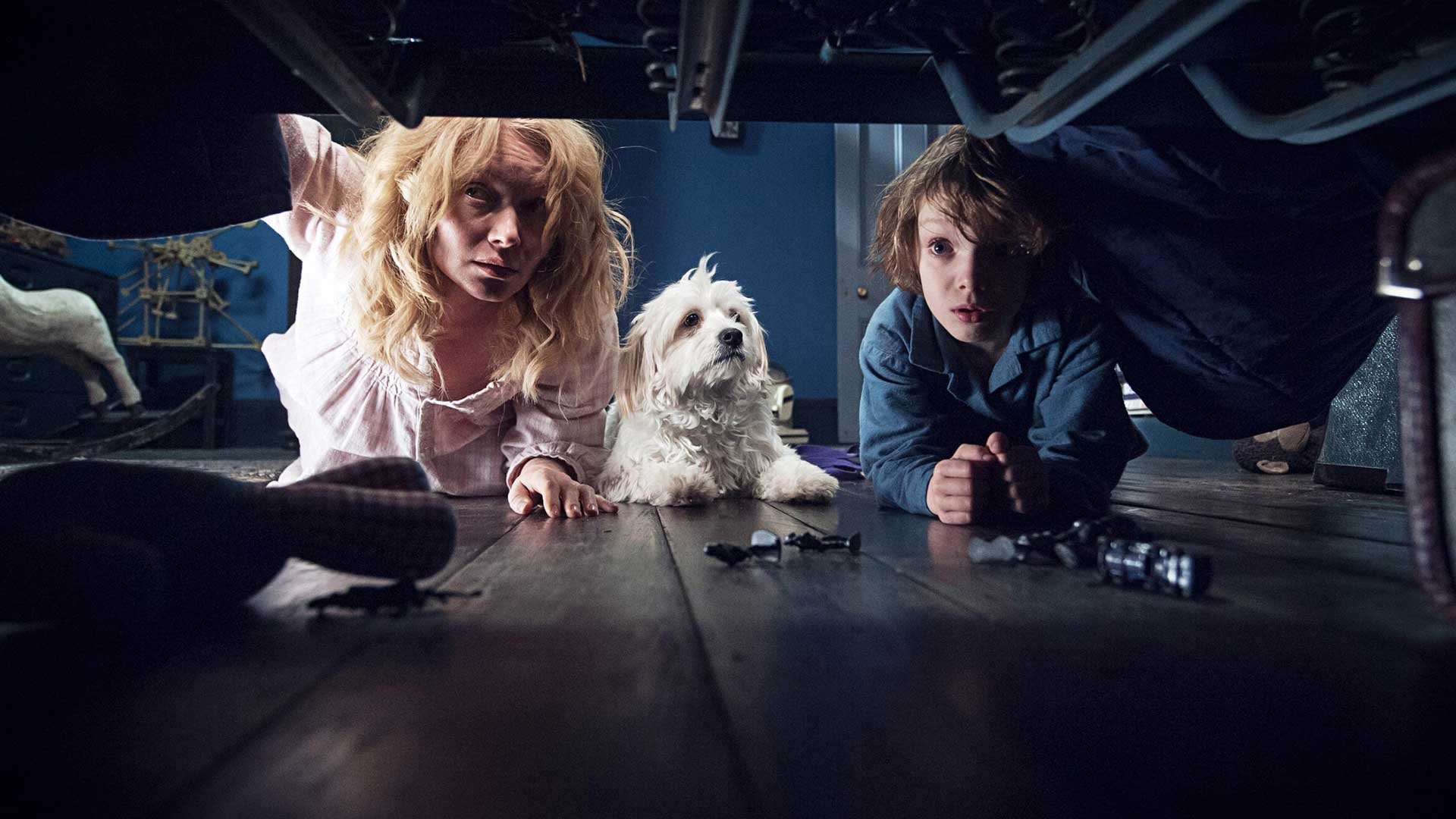[Editorial] The Babadook (2014)

The Babadook is a 2014 psychological horror, the directorial debut of Jennifer Kent. The film centres on the painful relationship between Amelia and her son Samuel, following the death of her husband. When a copy of Mister Babadook, a pop-up book that grows increasingly sinister with each turn of the page, arrives uninvited, Amelia unwittingly summons a dangerous presence that will threaten not only their sanity but also their lives.
According to Kent “I wanted to create a myth in a domestic setting. And even though it happened to be in some strange suburb in Australia somewhere, it could have been anywhere.” Kent achieves this universality through her creation of realistic, complex characters and the themes of grief and loss that are central to the film. The protagonist, Amelia, is a complex, multi-layered woman. This stems from both Kent’s writing and directorial ability and the acting skills of Essie Davis, who brings a raw, almost frenzied intensity to the role. The power of Amelia’s character comes from her refusal to conform to what is expected of her. Throughout the film we see her refusing to compartmentalise her grief and sadness to suit others, leading to her continued ostracization and alienation from those around her.

Amelia’s real crime is that she is breaking the rules, she's still sad and unable to move on, much to the irritation of those around her and she's so angry that she's threatening. She refuses to play to the narrative that her world and wellbeing is centred on, and sustained by- motherhood. She doesn’t like Samuel at times, though she loves him, because he is the constant reminder of her loss. This doesn’t make for much of a ‘yummy mummy’ and so she’s left on the side-lines, to watch her son face the same alienation because he’s weird, he’s morbid and he’s strange. The overwhelming lack of sympathy from those around Amelia and Samuel adds another element of horror, that their sadness makes them so unpalatable shines a light on how society treats grief, and how we police sadness.
GHOULS PODCAST
![[Ghouls Podcast] Maniac (2012) with Zoë Rose Smith and Iona Smith](https://images.squarespace-cdn.com/content/v1/5fe76a518d20536a3fbd7246/1696356006789-NYTG9N3IXCW9ZTIJPLX2/maniac.jpg)
Visually, Kent plays with light and dark, crafting a gloomy, haunted house aesthetic, with Amelia and Sam existing as two frail figures in a sombre grey house, living on just enough sustenance to survive. Alongside this saturation of grey, Kent uses elements of body horror, specifically physical trauma, as a means to externalise internal pain. Amelia finding glass in her soup is an apt metaphor for the cutting resentment she feels at having to care for her husband's murderer. Her toothache is a constant buzzing reminder of her heartache. As we see towards the end of the film, the only way to exorcise pain is to excise it, to cut it out and examine it. In Amelia’s case, this starts with a molar, and ends with the Babadook.
As Alexander Juhasz, designer of the film notes the Babadook is a complex, multifaceted character in his own right. He is a monster playing at being human, giving an approximation of what a man looks like, with his fixed, rictus grin and top hat. In this way, he is the dark half of Ameilia, who, for most of the film, is playing at being a mother who is coping with her loss. But, as Juhasz points out, he is also a “dark manifestation of repressed human emotions”, and it is in this capacity that we can understand Kent’s central theme of grief. He is all Amelia and Samuel’s darkness and pain made animate and terrifying. Every knock on the wardrobe, every sinister shadow, all shake loose more of these repressed feelings of anger, grief and sadness.

Kent also plays with the trope of the unreliable narrator; we are unsure for much of the film if the Babadook is real, or imagined, or if Amelia, or Samuel, are the architects of the increasingly ominous acts that surround them. This leads Amelia to question her own sanity, and gives the Babadook his way into her psyche. Amelia’s weakness is her refusal to let go of her grief, to move into acceptance of her husband’s death and let go of the rage she is nursing, closer to her than her own son. This weakness is exploited, in increasingly disturbing ways, and it is only by overcoming these emotional demons that she can vanquish their physical manifestation in the form of the Babadook. However, the Babadook is a very necessary evil. Through his torment, his terrorising and his relentless attempts to break Amelia and Samuel, he acts as the catharsis needed to push them out of the grey, endless stasis of their sadness, to move them back into the light and the world of the living. This is evoked starkly in the contrast with the greys and blacks of the majority of the film, and the sunny bright day we find Amelia and Samuel in at the closing scene.
The Babadook is a complex ode to grief, with Amelia trapped in her anger at the start of the film. Her resentment towards Samuel, towards life in general, has slowly eroded her sense of self, and she is trapped in a cycle of misery and sorrow. The arrival of the Babadook allows Amelia to break this cycle and provides an opportunity for Amelia and Samuel to unite to defeat a common enemy. This allows them to overcome their shared grief, and for Amelia to break down the walls she has built between herself and her son. The Babdook has a happy ending but one that is rooted in the realism of loss. The Babadook does not disappear, he shrinks, as sorrow does, and Amelia is able to manage him, by keeping him fed. The worms he feeds on are a visual metaphor for the breadcrumbs of memory that sustain all of us following the loss of a loved one. We can never vanquish our own personal Babadook's completely, because the purpose they serve is to allow us to remember the love we had that makes the loss so great. In this ending Kent reminds us that, as Nick Cave puts it, “grief is the terrible reminder of the depths of our love and, like love, grief is non-negotiable.”
RELATED ARTICLES
Possessor is a slick futuristic thriller in which Tasya Vos, an assassin for hire, must manage her responsibilities as an elite killing machine and complex feelings towards her husband and son, whilst taking on another high-profile job that will push her to the edge of her sanity.
Filmdom’s conventional wisdom in the mid-20th Century decreed that horror was no place for a lady. That is, unless it was as a shrieking victim dressed in a bosom-baring, diaphanous nightie…
When James Wan’s The Conjuring (2013) was first released, it set the tone for 2010s horror and was regarded by some horror fans as the beginning of a renaissance for the genre…
Helen Lyle is a triple threat. She is smart, charismatic and tenacious. An innovative researcher who wants to push the envelope. ..
Sara is a woman condemned from the start, first because of her religious beliefs…
Sara is host of a failing web series entitled Encounters which shows her meeting a range of offbeat people through personal ads…
The Babadook is a 2014 psychological horror, the directorial debut of Jennifer Kent…
It’s not wholly obvious in the first thirty minutes of Tobe Hooper’s The Texas Chainsaw Massacre just who our final girl will be…
When reassessing The Exorcist, there are implications of abuse brought on by Chris MacNeil’s reluctance to be a proper ‘mother’ to Regan…
Everyone must play, no outsiders allowed, nobody leaves.

EXPLORE
Now it’s time for Soho’s main 2023 event, which is presented over two weekends: a live film festival at the Whirled Cinema in Brixton, London, and an online festival a week later. Both have very rich and varied programmes (with no overlap this year), with something for every horror fan.
In the six years since its release the Nintendo Switch has amassed an extensive catalogue of games, with everything from puzzle platformer games to cute farming sims to, uh, whatever Waifu Uncovered is.
A Quiet Place (2018) opens 89 days after a race of extremely sound-sensitive creatures show up on Earth, perhaps from an exterritorial source. If you make any noise, even the slightest sound, you’re likely to be pounced upon by these extremely strong and staggeringly fast creatures and suffer a brutal death.
If you like cults, sacrificial parties, and lesbian undertones then Mona Awad’s Bunny is the book for you. Samantha, a student at a prestigious art university, feels isolated from her cliquey classmates, ‘the bunnies’.
The slasher sub genre has always been huge in the world of horror, but after the ‘70s and ‘80s introduced classic characters like Freddy Krueger, Michael Myers, Leatherface, and Jason, it’s not harsh to say that the ‘90s was slightly lacking in the icon department.
Mother is God in the eyes of a child, and it seems God has abandoned the town of Silent Hill. Silent Hill is not a place you want to visit.
Being able to see into the future or back into the past is a superpower that a lot of us would like to have. And while it may seem cool, in horror movies it usually involves characters being sucked into terrifying situations as they try to save themselves or other people with the information they’ve gleaned in their visions.
Both the original Pet Sematary (1989) and its 2019 remake are stories about the way death and grief can affect people in different ways. And while the films centre on Louis Creed and his increasingly terrible decision-making process, there’s no doubt that the story wouldn’t pack the same punch or make the same sense without his wife, Rachel.
The story focuses on a group of survivors after most of the world’s population is wiped out by Captain Trips, a lethal super-flu. And while there are enough horrors to go around in a story like this, the real focus of King’s book is how those who survive react to the changing world around them.
While some films successfully opt to leave the transformation scene out completely, like the wonderful Dog Soldiers (2002), those who decide to include it need to make sure they get it right, or it can kill the whole vibe of the film. So load up on silver bullets, mark your calendar for the next full moon, and check out 11 of the best werewolf transformations!


![[Ghouls Podcast] The Last House on the Left (2009) with Zoë Rose Smith and Jerry Sampson](https://images.squarespace-cdn.com/content/v1/5fe76a518d20536a3fbd7246/1687863043713-54DU6B9RC44T2JTAHCBZ/last+house+on+the+left.jpg)
![[Ghouls Podcast] The Bay (2012) with Ariel Powers-Schaub & Amber T](https://images.squarespace-cdn.com/content/v1/5fe76a518d20536a3fbd7246/1684751617262-6K18IE7AO805SFPV0MFZ/The+Bay+website+image.jpg)
![[Ghouls Podcast] Picnic at Hanging Rock (1975) with Zoë Rose Smith & Rebecca McCallum](https://images.squarespace-cdn.com/content/v1/5fe76a518d20536a3fbd7246/1682536446302-I2Y5IP19GUBXGWY0T85V/picnic+at+hanging+rock.jpg)
![[Ghouls Podcast] Psychotic Women in Horror with Zoë Rose Smith & Mary Wild](https://images.squarespace-cdn.com/content/v1/5fe76a518d20536a3fbd7246/1678635495097-X9TXM86VQDWCQXCP9E2L/Copy+of+Copy+of+Copy+of+GHOULS+PODCAST+THE+LOVED+ONES.jpg)
![[Ghouls Podcast] Nekromantik with Zoë Rose Smith & Rebecca McCallum](https://images.squarespace-cdn.com/content/v1/5fe76a518d20536a3fbd7246/1677422649033-Z4HHPKPLUPIDO38MQELK/feb+member+podcast.jpg)
![[Ghouls Podcast] Final Destination 5 & Wrap-up with Ariel Powers-Schaub & Iona Smith](https://images.squarespace-cdn.com/content/v1/5fe76a518d20536a3fbd7246/1672841326335-WER2JXX7WP6PO8JM9WB2/PODCAST+BONUS+2023+%284%29.jpg)
![[Ghouls Podcast] Final Destination 3 & 4 with Ariel Powers-Schaub & Iona Smith](https://images.squarespace-cdn.com/content/v1/5fe76a518d20536a3fbd7246/1672841151148-U152EBCTCOP4MP9VNE70/PODCAST+BONUS+2023+%283%29.jpg)
![[Ghouls Podcast] Final Destination 1 & 2 with Ariel Powers-Schaub & Iona Smith](https://images.squarespace-cdn.com/content/v1/5fe76a518d20536a3fbd7246/1672841181605-5JOOW88EDHGQUXSRHVEF/PODCAST+BONUS+2023+%282%29.jpg)
![[Ghouls Podcast] Henry: Portrait of a Serial Killer (1986)](https://images.squarespace-cdn.com/content/v1/5fe76a518d20536a3fbd7246/1672841247731-65K0JKNC45PJE9VZH5SB/PODCAST+BONUS+2023+%281%29.jpg)
![[Ghouls Podcast] A Serbian Film with Rebecca and Zoë](https://images.squarespace-cdn.com/content/v1/5fe76a518d20536a3fbd7246/1672841382382-RY0U5K7XD4SQSTXL2D14/PODCAST+BONUS+2023.jpg)
![[Editorial] In Her Eyes: Tasya Vos in Possessor (2020)](https://images.squarespace-cdn.com/content/v1/5fe76a518d20536a3fbd7246/1667061747115-NTIJ7V5H2ULIEIF32GD0/Image+1+%285%29.jpg)
![[Editorial] Margaret Robinson: Hammer’s Puppeteer](https://images.squarespace-cdn.com/content/v1/5fe76a518d20536a3fbd7246/1630075489815-33JJN9LSGGKSQ68IGJ9H/MV5BMjAxMDcwNDI2Nl5BMl5BanBnXkFtZTcwOTMxODgzMQ%40%40._V1_.jpg)
![[Editorial] Lorraine Warren’s Clairvoyant Gift](https://images.squarespace-cdn.com/content/v1/5fe76a518d20536a3fbd7246/1648576580495-0O40265VK7RN03R515UO/Image+1+%281%29.jpg)
![[Editorial] In Her Eyes: Helen Lyle in Candyman (1992)](https://images.squarespace-cdn.com/content/v1/5fe76a518d20536a3fbd7246/1649586854587-DSTKM28SSHB821NEY7AT/image1.jpg)
![[Editorial] In Her Eyes: Sara Lowes in Witchfinder General (1968)](https://images.squarespace-cdn.com/content/v1/5fe76a518d20536a3fbd7246/1655655953171-8K41IZ1LXSR2YMKD7DW6/hilary-heath.jpeg)
![[Editorial] Sara in Creep 2 (2017)](https://images.squarespace-cdn.com/content/v1/5fe76a518d20536a3fbd7246/1646478850646-1LMY555QYGCM1GEXPZYM/27ebc013-d50a-4b5c-ad9c-8f8a9d07dc93.jpg)
![[Editorial] The Babadook (2014)](https://images.squarespace-cdn.com/content/v1/5fe76a518d20536a3fbd7246/1651937631847-KR77SQHST1EJO2729G7A/Image+1.jpg)
![[Editorial] Sally Hardesty in The Texas Chainsaw Massacre (1974)](https://images.squarespace-cdn.com/content/v1/5fe76a518d20536a3fbd7246/1637247162929-519YCRBQL6LWXXAS8293/the-texas-chainsaw-final-girl-1626988801.jpeg)
![[Editorial] Re-assessing The Exorcist: Religion, Abuse, and The Rise of the Feminist Mother.](https://images.squarespace-cdn.com/content/v1/5fe76a518d20536a3fbd7246/1629995626135-T5K61DZVA1WN50K8ULID/image2.jpg)
![[Editorial] Unravelling Mitzi Peirone’s Braid (2018)](https://images.squarespace-cdn.com/content/v1/5fe76a518d20536a3fbd7246/1628359114427-5V6LFNRNV6SD81PUDQJZ/4.jpg)






















![[Editorial] 10 Films & Events to Catch at Soho Horror Film Fest 2023](https://images.squarespace-cdn.com/content/v1/5fe76a518d20536a3fbd7246/1700819417135-299R7L4P0B676AD3RO1X/Screenshot+2023-11-24+at+09.41.52.png)
![[Editorial] 9 Horror Nintendo Switch Games To Play](https://images.squarespace-cdn.com/content/v1/5fe76a518d20536a3fbd7246/1697214470057-3XZXX8N4LYIMDFWS6Z3P/Screenshot+2023-10-13+at+17.20.13.png)
![[Mother of Fears] Mothering in Silence in A Quiet Place (2018)](https://images.squarespace-cdn.com/content/v1/5fe76a518d20536a3fbd7246/1696445921315-HZJ2DZYQIH6VVWXBO2YL/Screenshot+2023-10-04+at+19.52.29.png)
![[Editorial] 5 Female Focused Horror Book Recommendations](https://images.squarespace-cdn.com/content/v1/5fe76a518d20536a3fbd7246/1696441981361-52EQCTJ7AT2QF1927GM7/919xtm6d3fL._AC_UF894%2C1000_QL80_.jpg)
![[Editorial] 9 Best Slashers Released Within 10 Years of Scream (1996)](https://images.squarespace-cdn.com/content/v1/5fe76a518d20536a3fbd7246/1695478839037-LOFHGVM3H6BMSZW7G83M/Screenshot+2023-09-23+at+15.15.11.png)
![[Mother of Fears] Mother Vs. Monster in Silent Hill (2006)](https://images.squarespace-cdn.com/content/v1/5fe76a518d20536a3fbd7246/1695485781119-H6GNP0G3J2TLPAOIABV7/Screenshot+2023-09-23+at+17.11.56.png)
![[Editorial] 9 Terrifying Cerebral Visions in Horror Movies](https://images.squarespace-cdn.com/content/v1/5fe76a518d20536a3fbd7246/1693509801235-X23OL50T1DVGECH0ZJK2/MV5BMjQ0MTg2MjQ4MV5BMl5BanBnXkFtZTgwMTU3NDgxMTI%40._V1_.jpg)
![[Mother of Fears] I Don’t Wanna Be Buried in a Pet Sematary (1989) and (2019)](https://images.squarespace-cdn.com/content/v1/5fe76a518d20536a3fbd7246/1691328766069-QFNAVJOMFZVZ5CLU1RWM/Screenshot+2023-08-06+at+14.23.13.png)
![[Mother of Fears] How I Love to Love Nadine in The Stand (2020)](https://images.squarespace-cdn.com/content/v1/5fe76a518d20536a3fbd7246/1690213172707-TKM9MZXK02EVCIX30M1V/Screenshot+2023-07-24+at+16.29.11.png)
![[Editorial] 11 Best Werewolf Transformations in Horror Films](https://images.squarespace-cdn.com/content/v1/5fe76a518d20536a3fbd7246/1689240234098-HUPQC6L57AAHFJNT8FTE/Screenshot+2023-07-13+at+10.09.13.png)
